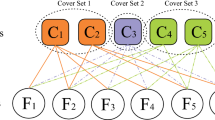Abstract
In future smart-cities, public transportation vehicles are planned to serve as data couriers (DCs) in order to exchange massive amounts of data chunks. In this research, we study the path planning problem for these DCs while optimizing their counts and their total traveled distances. As the total collected load on a given DC route cannot exceed its storage capacity, it is important to decide on the size of the exchanged data-packets (images, videos, etc.) and the sequence of the targeted data sources to be visited. We propose a hybrid heuristic approach for public data delivery in smart-city settings. In this approach, public vehicles are utilized as DCs that read/collect data from numerously distributed Access Points (APs) and relay it back to a central processing base-station in the city. We also introduce a cost-based fitness function for DCs election in the smart-city paradigm. Our cost-based function considers resource limitations in terms of DCs count, storage capacity, and energy consumption. Extensive simulations are performed, and the results confirm the effectiveness of the proposed approach in comparison to other heuristic approaches with respect to total traveled distances and overall time complexity.








Similar content being viewed by others
References
Singh G, Al-Turjman F (2016) A data delivery framework for cognitive information-centric sensor networks in smart outdoor monitoring. Elsevier Computer Communications Journal 74(1):38–51
Al-Turjman F, Hassanein H, Ibnkahla M (2013) Efficient deployment of wireless sensor networks targeting environment monitoring applications. Elsevier Computer Communications Journal 36(2):135–148
Al-Turjman F, Hassanein H, and Oteafy S 2011 Towards augmenting federated wireless sensor networks. In Proc. of the IEEE International Conf. on Ambient Systems, Networks and Technologies (ANT), Niagara, ON. Canada 224–231
Al-Turjman F 2016 Cognition in information-centric sensor networks for IoT applications: an overview. Ann. Telecommun 1–16 DOI: 10.1007/s12243-016-0533-8
Alsalih W, Hassanein H, and Akl S (2009) Routing to a mobile data collector on a predefined trajectory. In Proc. IEEE International Conference on Communications (ICC), Dresden, Germany 1–5
Al-Fagih A, Al-Turjman F, Alsalih W, Hassanein H (2013) A priced public sensing framework for heterogeneous IoT architectures. IEEE Transactions on Emerging Topics in Computing 1(1):133–147
Al-Turjman F, Hassanein H, Alsalih W, Ibnkahla M (2011) Optimized relay placement for wireless sensor networks Federation in Environmental Applications. Wiley: Wireless Communication & Mobile Computing Journal 11(12):1677–1688
Azad A and Chockalingam A (2006) Mobile base stations placement and energy aware routing in wireless sensor networks. In Proc. IEEE Wireless Communications and Networking Conference (WCNC) Las Vegas, NV 264–269
Masoud AA (2013) A harmonic potential field approach for joint planning & control of a rigid, separable nonholonomic, mobile robot. Elsevier: Robotics and Autonomous Systems 61(6):593–615
Zhang Y, Fattahi N, and Li W(2013) Probabilistic roadmap with self-learning for path planning of a mobile robot in a dynamic and unstructured environment. IEEE Inter. Conf. on Mechatronics and Automation (ICMA), Takamatsu
Al-Turjman F, Hassanein H, Ibnkahla M (2013) Quantifying connectivity in wireless sensor networks with grid-based deployments. Elsevier: Journal of Network & Computer Applications 36(1):368–377
LaValle S M and Kuffner J J 2000 Rapidly-exploring random trees: progress and prospects
Tiu J and Yang S X (2003) Genetic algorithm based path planning for mobile robots. IEEE Conference on Robotics and Automation (ICRA), Taipei, Taiwan
Wang L, Yang S X, and Biglarbegian M (2012) A fuzzy logic based bio-inspired system for mobile robot navigation. IEEE Conference on Multisensor Fusion and Integration for Intelligent Systems (MFI), Hamburg, Germany
Al-Turjman F, Hassanein H, Ibnkahla M (2015) Towards prolonged lifetime for deployed WSNs in outdoor environment monitoring. Elsevier Ad Hoc Networks Journal 24(A):172–185
Al-Harbi S, Noor F, Al-Turjman F (2007) March DSS: a new diagnostic march test for all memory simple static faults. IEEE Transactions on CAD of Integrated Circuits and Systems 26(9):1713–1720
Parvez W and Dhar S (2013) Path planning of robot in static environment using genetic algorithm (GA) technique. International Journal of Advances in Engineering & Technology
Castillo O and Trujillo L 2005 Multiple Objective optimization genetic algorithms for path planning in autonomous mobile robots International Journal of Computers, Systems and Signals 6 (1)
Achour N and Chaalal M (2011) Mobile robots path planning using genetic algorithms. The Seventh International Conference on Autonomic and Autonomous Systems
ITU-T Series Y 2010 Recommendation: ITU-T Y.2221; Requirements for support of ubiquitous sensor network applications and services in the NGN environment
Qua1comm, “LTE-advanced: Heterogeneous networks” 2011 http://www.qualcomm.com/media/documents/lte-heterogeneous-networks
Ahmed I, Qazi B, and Elmirghani J 2012 Base stations locations optimisation in an airport environment using genetic algorithms, In Proc. Int. Wireless Commun. And Mobile Comput. Conf. (IWCMC) 24–29
Strzyz S and et al. 2011 Performance optimization of pico node deployment in LTE macro cells. In Proc. Future Network Mobile Summit (FutureNetw 1–9
AlSalibi B A, Jelodar M B, and Venkat I (2013) A comparative study between the nearest neighbor and genetic algorithms: a revisit to the traveling salesman problem. Int. J. of Computer Science and Electronics Eng. (IJCSEE) 1(1)
Singh G, Al-Turjman F (2016) Learning data delivery paths in QoI-aware information-centric sensor networks. IEEE Internet of Things Journal 3(4):572–580
Author information
Authors and Affiliations
Corresponding author
Rights and permissions
About this article
Cite this article
Al-Turjman, F., Karakoc, M. & Gunay, M. Path planning for mobile DCs in future cities. Ann. Telecommun. 72, 119–129 (2017). https://doi.org/10.1007/s12243-016-0557-0
Received:
Accepted:
Published:
Issue Date:
DOI: https://doi.org/10.1007/s12243-016-0557-0




